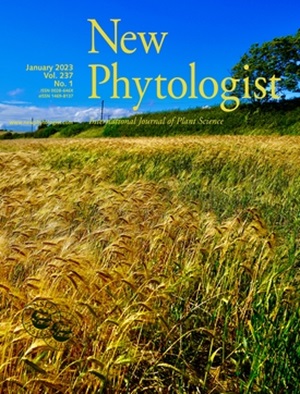Inorganic carbon levels regulate growth via SigC signaling cascade in cyanobacteria.
IF 8.1
1区 生物学
Q1 PLANT SCIENCES
引用次数: 0
Abstract
Cyanobacterial growth depends on inorganic carbon (Ci; CO2 and bicarbonate) concentration, but mechanism(s) adjusting photosynthesis and growth according to Ci remain unclear. ΔrpoZ cells lacking the ω subunit of the RNA polymerase (RNAP) show a unique high-CO2 lethal phenotype in Synechocystis sp. PCC 6803. Bioinformatics, biochemical and 3D modeling studies were used to reveal how suppressor mutations rescue ΔrpoZ cells in 3% CO2. Suppressor mutations were mapped to the ssr1600 gene. Ssr1600 was shown to function as an anti-σ factor antagonist. The Slr1861 protein was identified as an anti-σ factor and as an Ssr1600 kinase. The Slr1861/Ssr1600 pair was shown to control the formation of RNAP-SigC holoenzyme using a phosphorylation-controlled partner-switching mechanism. In high CO2, excess formation of growth-limiting RNAP-SigC holoenzyme in ΔrpoZ reduces the expression of cell wall synthesis, photosynthetic and nutrient uptake genes, leading to low photosynthesis activity and cell lysis. In the suppressor mutants, drastically decreased Ssr1600 levels lowered the amounts of RNAP-SigC holoenzyme to similar levels as in the control strain, returning an almost normal transcriptome composition, photosynthesis and growth. The results indicate that SigC, Slr1861 and Ssr1600 proteins form a growth-regulating signaling cascade in cyanobacteria, which connects growth to environmental Ci levels.蓝藻中的无机碳水平通过SigC信号级联调节生长。
蓝藻的生长依赖于无机碳(Ci;CO2和碳酸氢盐)浓度,但根据Ci调节光合作用和生长的机制尚不清楚。在Synechocystis sp. PCC 6803中,缺乏RNA聚合酶(RNAP) ω亚基的ΔrpoZ细胞表现出独特的高co2致死表型。生物信息学、生化和3D建模研究揭示了抑制突变如何在3% CO2中拯救ΔrpoZ细胞。抑制基因突变定位于ssr1600基因。Ssr1600具有抗σ因子拮抗剂的作用。Slr1861蛋白被鉴定为抗σ因子和Ssr1600激酶。Slr1861/Ssr1600对通过磷酸化控制的伴侣转换机制控制RNAP-SigC全酶的形成。在高CO2环境下,ΔrpoZ中生长限制性RNAP-SigC全酶的过量形成降低了细胞壁合成、光合作用和营养摄取基因的表达,导致光合作用活性降低和细胞裂解。在抑制突变体中,急剧降低的Ssr1600水平将RNAP-SigC全酶的数量降低到与对照菌株相似的水平,恢复了几乎正常的转录组组成、光合作用和生长。结果表明,SigC、Slr1861和Ssr1600蛋白在蓝藻中形成了一个调节生长的信号级联,将生长与环境Ci水平联系起来。
本文章由计算机程序翻译,如有差异,请以英文原文为准。
求助全文
约1分钟内获得全文
求助全文
来源期刊

New Phytologist
生物-植物科学
自引率
5.30%
发文量
728
期刊介绍:
New Phytologist is an international electronic journal published 24 times a year. It is owned by the New Phytologist Foundation, a non-profit-making charitable organization dedicated to promoting plant science. The journal publishes excellent, novel, rigorous, and timely research and scholarship in plant science and its applications. The articles cover topics in five sections: Physiology & Development, Environment, Interaction, Evolution, and Transformative Plant Biotechnology. These sections encompass intracellular processes, global environmental change, and encourage cross-disciplinary approaches. The journal recognizes the use of techniques from molecular and cell biology, functional genomics, modeling, and system-based approaches in plant science. Abstracting and Indexing Information for New Phytologist includes Academic Search, AgBiotech News & Information, Agroforestry Abstracts, Biochemistry & Biophysics Citation Index, Botanical Pesticides, CAB Abstracts®, Environment Index, Global Health, and Plant Breeding Abstracts, and others.
 求助内容:
求助内容: 应助结果提醒方式:
应助结果提醒方式:


